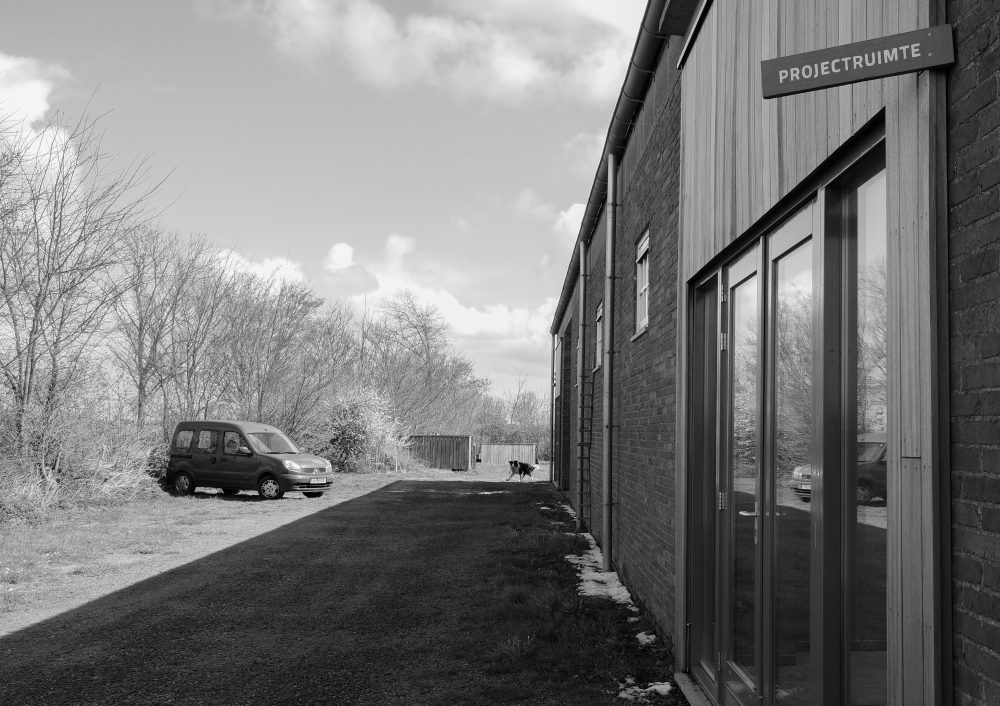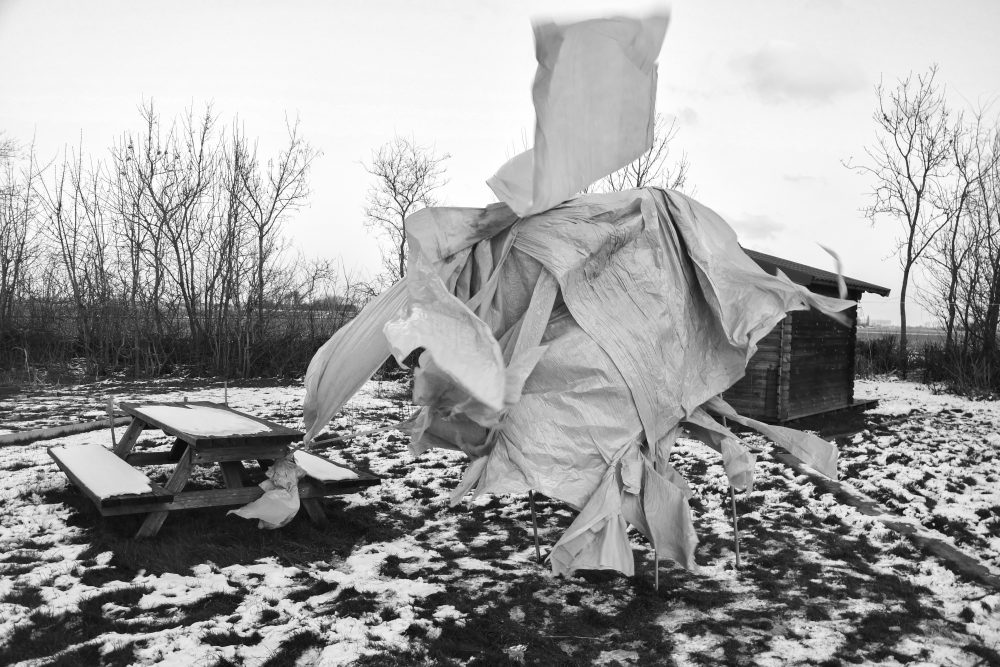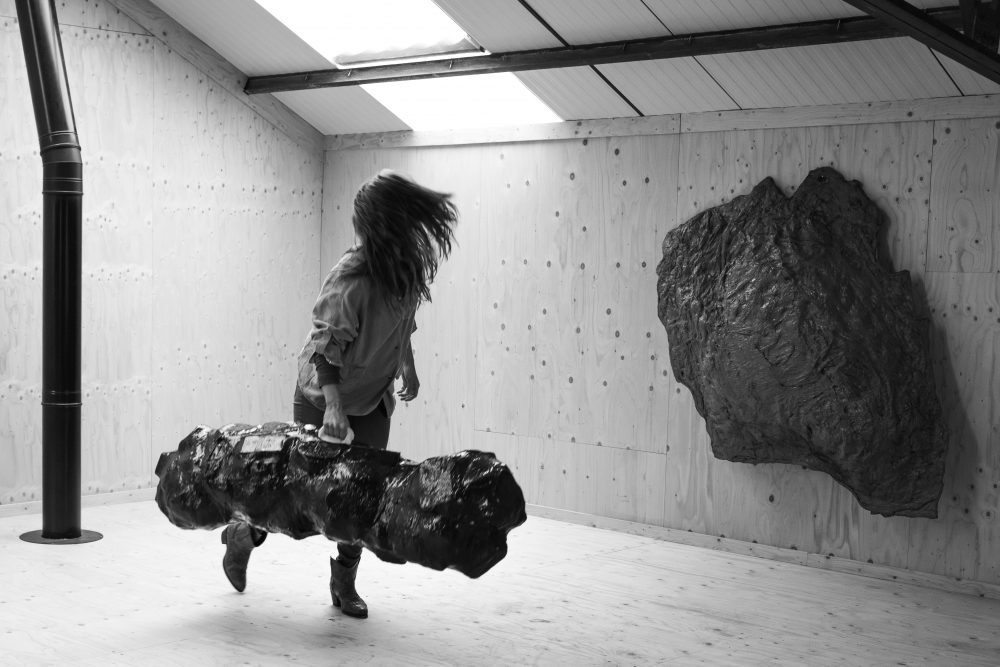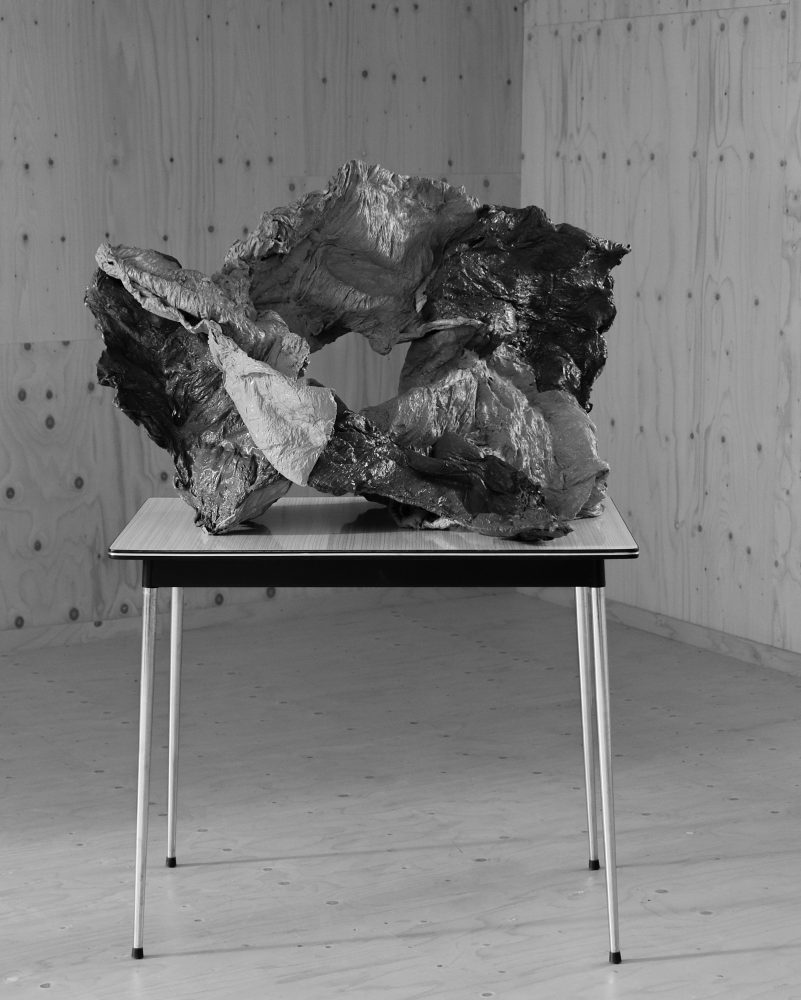Plastikos
From the 1st of February until the end of April sculptor Jan Eric Visser is staying as artist-in-residence at VierVaart in Groede, a temporary inland studio of the Mondriaan Fund. VierVaart, located on a former farm in the polder landscape of Zeeuws-Vlaanderen, brings together visual art, organic gardening and staying in nature. VierVaart was founded in 2016 by Iris Cornelis and Maartje Korstanje in collaboration with Maartje's parents, Piet Korstanje and Heleen van Elsacker. Jan Eric Visser's professional practice focuses entirely on the transformation of his personal inorganic household waste into autonomous sculptures. His works address the circularity of nature and the life cycle present in everything.

Waste and food
Bales of silage in meadows and piled up at farms. Characteristic volumes in well thought out colours, but what actually happens to all the plastic when the silage is fed? to the cattle? This central question immediately puts my residency on edge. After all, you can difficult to question the ecological feasibility of our food production while you yourself produces waste and wastes resources.
As always, I don't want to produce any waste during the work process. That's my whole artists' lives, but it is also a complex experiment that requires a great deal of thought. Waste is usually inherent in creation and experimentation. However, I don't want to throw anything away and I don't want to leave anything behind, not even under time pressure. Also I want to I keep looking at my own consumption patterns. At VierVaart there is a large organic garden with compost bins. There I can put my organic But how do I avoid residual waste in this temporary context?

After all, it is difficult to question the ecological feasibility of our food production while producing waste and wasting raw materials yourself.
Upon arrival, I immediately make contact with the farmers in the area who have already been approached, to collect the wrapping film that was saved for me. The packages appear to smell quite bad: the plastic is soiled and wet. It must first be cleaned, but how do I do that without using chemicals and not too much water? Can it be done in the adjoining canal? I have to peel off a lot of waste foil layer by layer. The association with peeling shrimps forces itself upon me. The hung drying sheets in turn evoke the association with the skins of slaughtered animals. When the weather I hang the plastic over branches and on sticks outside to dry. In no time I am in the rhythm of the countryside where all work is adapted to the weather.
I do not want to produce waste during the work process
In between I do experiments with this for me new waste material. Will it shrink, stretch, fold, cut, tear, bond together, et cetera. Can I use it to create height or volume without using glue or other additives? On request I receive from a local Roman Catholic church a quantity of devotional candlesticks. With this wax I can probably make connections or solve other problems. Along the way I come across a waste wooden plate and pallet. This turns out to be an ideal work table, which in time will be used again for will be reallocated.

Dilemmas
In the present studio surrounded by cleaned plastic foil in different shades of green the first trials produce the first small works. But how do I scale up? The project space at VierVaart, where a presentation will take place afterwards, is spacious. I feel a desire for monumentality, but also the preservation of human scale. Perhaps this cost a lot of energy? A view of the roof removes some of this objection: 35 solar panels! While I'm in the studio struggling with material, gravity and size, I struggle in the available apartment with my daily waste. The best thing would be to have everything rebuild as they do here at VierVaart. I have known that for a long time. However, living autarkically takes a lot of time and comes at a cost. for art. This residency puts my eternal The dilemma between being human and being an artist is once again exposed.
This residency once again exposes my eternal dilemma between being human and being an artist.
Iris comes by to take some photos. Her gaze falls on a recently completed abstract work that I have placed on an existing formica dining table. The proportions are exactly right. Food and waste seem to be inextricably linked from production to consumption: construction and demolition in one. Cautiously Iris inquires whether she has lost her vintage table to a work of art?
Naphtha
High time to find out what this film is. Can it hurt to work with this? Inquiries reveal that the material is low density polyethylene (LDPE). This is a thermoplastic made from oil. The production of plastic, as we know, begins with the distillation of crude oil in an oil refinery. In this process the heavy crude oil is separated into groups of lighter components called fractions. One of these fractions is naphtha, which is the most important fraction for the production of plastics, including LDPE.
This duality in the title appeals to me: art and the environment, two giants that I have united for so long
The wrapping film appears to be related to the plastic bag, cling film and other food packaging. The toughness and elongation is due to the production process which causes the molecules to branch off strongly. LDPE is perfectly recyclable, so I read. I came across a company video online of a company that, for a fee, collects waste foil from a happy farmer. His foil is cleaned, extruded, granulated and then mixed with new LPDE for e.g. the well-known KOMO garbage bag. An example of downcycling in an oil-ruled so-called circular economy, which continues to regurgitate plastic and fuel incinerators. This will only stop when we leave the fossil era behind and move to renewables.
Hold on
In the meantime, the days are stringing together. I enjoy the peace, space and pleasant atmosphere. An occasional walk on the beach offers welcome variety. So is an outing to the fishmonger's in Breskens. Enjoying a fried fish on the quay, my eye is drawn to a large quantity of red, blue, green and white pieces of plastic rope that have been left behind are on the pavement. A man asks me what I do when I start picking them up. He tells me it comes from Urk fishermen who moor here. During the mending of the nets they play loud church music. I look in my little bucket of color. Colour is always welcome and at least this will not blow into the sea.

I am beginning to feel a grip. Perhaps I will succeed in penetrating to the essence of the material in a relatively short time. Under my hands first a black amorphous object arises siloplastic filled with soiled hard-to-clean wrapping film that I'd like to get rid of. On the object I apply a white handle from a container that contained ecological detergent. This creates a Take Away sculpture that lies well in the hand. Instagrammable I note with some irony.
What remains is the question why we as humanity so pollute our nest
Using the worktable as a mold a relief of several layers of plastic. I bring put half an orange peel on it, because we can't put it in the biocompost bin. Subsequently, I end up in a quest for transformation and form. Every new form offers me the prospect of a new way of life and survival strategy, in which everything is of value and nothing goes to waste. Meanwhile the studio is getting overcrowded. I decide to move some of the works to the presentation room. also to see how they behave in space.
What's left
The end of the residency is in sight, so not the coronagraphs. The official opening of the exhibition is postponed, but the title is fixed: Plastikos. Plastikós is the Greek word for malleable, mouldable. The word plastic in the sense of malleable material is derived from it. This also applies for the word plastic, a term from the art of sculpture that refers to a form that arises from a malleable mass. This duality in the title appeals to me: art and the environment, two giants that I have united for so long. Moreover, the title sums up the core of my work here: upgrading plastic and shaping it into plastic.

At the end of my working period I look back with satisfaction on a productive time. Partly due to corona, I was thrown back on my own, but on the erf I was in pleasant company. I feel grateful for this place, which is so in harmony with nature.
What remains is the question of why we, as humanity, pollute our nest so much. Waste exposes the collective inability to understand something essential and to relate to it. to the fragile cycle of life. I am reminded of two lines from a poem by Gerrit Kouwenaar on one of the Roteb garbage trucks in Rotterdam, the city where I return after my residency:
what remains is the riddle, freed of its sins
it's clear as garbage, delicious as truth


